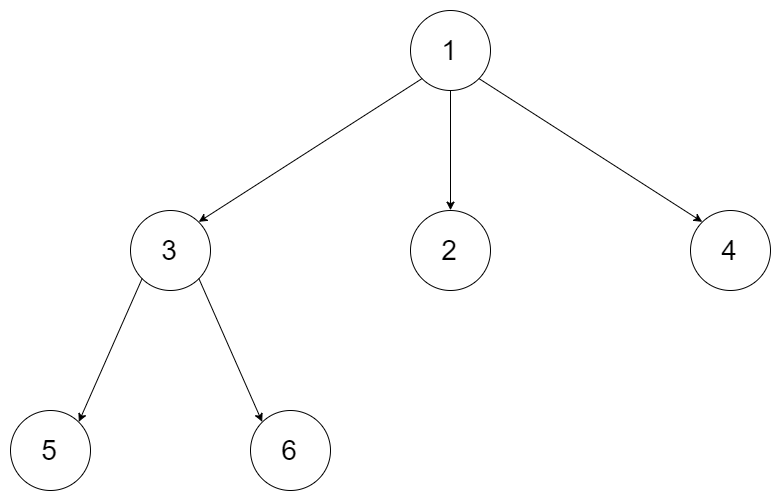LC 589. N 叉树的前序遍历
题目描述
这是 LeetCode 上的 589. N 叉树的前序遍历 ,难度为 简单。
给定一个 $n$ 叉树的根节点 root,返回其节点值的前序遍历 。
$n$ 叉树在输入中按层序遍历进行序列化表示,每组子节点由空值 null 分隔(请参见示例)。
示例 1:

1 | |
示例 2:

1 | |
提示:
- 节点总数在范围 $[0, 10^4]$ 内
- $0 <= Node.val <= 10^4$
- $n$ 叉树的高度小于或等于 $1000$
进阶:递归法很简单,你可以使用迭代法完成此题吗?
递归
常规做法,不再赘述。
Java 代码:1
2
3
4
5
6
7
8
9
10
11
12class Solution {
List<Integer> ans = new ArrayList<>();
public List<Integer> preorder(Node root) {
dfs(root);
return ans;
}
void dfs(Node root) {
if (root == null) return ;
ans.add(root.val);
for (Node node : root.children) dfs(node);
}
}
C++ 代码:1
2
3
4
5
6
7
8
9
10
11
12
13class Solution {
public:
vector<int> ans;
vector<int> preorder(Node* root) {
dfs(root, ans);
return ans;
}
void dfs(Node* root, vector<int>& ans) {
if (!root) return;
ans.push_back(root->val);
for (Node* node : root->children) dfs(node, ans);
}
};
Python 代码:1
2
3
4
5
6
7
8
9
10
11class Solution:
def preorder(self, root: 'Node') -> List[int]:
ans = []
def dfs(node):
if not node:
return
ans.append(node.val)
for child in node.children:
dfs(child)
dfs(root)
return ans
- 时间复杂度:$O(n)$
- 空间复杂度:忽略递归带来的额外空间开销,复杂度为 $O(1)$
迭代
针对本题,使用「栈」模拟递归过程。
迭代过程中记录 (node = 当前节点, cnt = 当前节点遍历过的子节点数量) 二元组,每次取出栈顶元素,如果当前节点是首次出队(当前遍历过的子节点数量为 $cnt = 0$),则将当前节点的值加入答案,然后更新当前元素遍历过的子节点数量,并重新入队,即将 $(node, cnt + 1)$ 入队,以及将下一子节点 $(node.children[cnt], 0)$ 进行首次入队。
Java 代码;1
2
3
4
5
6
7
8
9
10
11
12
13
14
15
16
17
18class Solution {
public List<Integer> preorder(Node root) {
List<Integer> ans = new ArrayList<>();
Deque<Object[]> d = new ArrayDeque<>();
d.addLast(new Object[]{root, 0});
while (!d.isEmpty()) {
Object[] poll = d.pollLast();
Node t = (Node)poll[0]; Integer cnt = (Integer)poll[1];
if (t == null) continue;
if (cnt == 0) ans.add(t.val);
if (cnt < t.children.size()) {
d.addLast(new Object[]{t, cnt + 1});
d.addLast(new Object[]{t.children.get(cnt), 0});
}
}
return ans;
}
}
C++ 代码:1
2
3
4
5
6
7
8
9
10
11
12
13
14
15
16
17
18
19class Solution {
public:
vector<int> preorder(Node* root) {
vector<int> ans;
stack<pair<Node*, int>> stk;
stk.push({root, 0});
while (!stk.empty()) {
auto [node, cnt] = stk.top();
stk.pop();
if (!node) continue;
if (cnt == 0) ans.push_back(node->val);
if (cnt < node->children.size()) {
stk.push({node, cnt + 1});
stk.push({node->children[cnt], 0});
}
}
return ans;
}
};
Python 代码:1
2
3
4
5
6
7
8
9
10
11
12
13
14class Solution:
def preorder(self, root: 'Node') -> List[int]:
ans = []
stk = [(root, 0)]
while stk:
node, cnt = stk.pop()
if not node:
continue
if cnt == 0:
ans.append(node.val)
if cnt < len(node.children):
stk.append((node, cnt + 1))
stk.append((node.children[cnt], 0))
return ans
- 时间复杂度:$O(n)$
- 空间复杂度:$O(n)$
通用「递归」转「迭代」
另外一种「递归」转「迭代」的做法,是直接模拟系统执行「递归」的过程,这是一种更为通用的做法。
由于现代编译器已经做了很多关于递归的优化,现在这种技巧已经无须掌握。
在迭代过程中记录当前栈帧位置状态 loc,在每个状态流转节点做相应操作。
Java 代码:1
2
3
4
5
6
7
8
9
10
11
12
13
14
15
16
17
18
19
20
21
22class Solution {
public List<Integer> preorder(Node root) {
List<Integer> ans = new ArrayList<>();
Deque<Object[]> d = new ArrayDeque<>();
d.addLast(new Object[]{0, root});
while (!d.isEmpty()) {
Object[] poll = d.pollLast();
Integer loc = (Integer)poll[0]; Node t = (Node)poll[1];
if (t == null) continue;
if (loc == 0) {
ans.add(t.val);
d.addLast(new Object[]{1, t});
} else if (loc == 1) {
int n = t.children.size();
for (int i = n - 1; i >= 0; i--) {
d.addLast(new Object[]{0, t.children.get(i)});
}
}
}
return ans;
}
}
C++ 代码:1
2
3
4
5
6
7
8
9
10
11
12
13
14
15
16
17
18
19
20
21
22class Solution {
public:
vector<int> preorder(Node* root) {
vector<int> ans;
stack<pair<int, Node*>> stk;
stk.push({0, root});
while (!stk.empty()) {
auto [loc, node] = stk.top();
stk.pop();
if (!node) continue;
if (loc == 0) {
ans.push_back(node->val);
stk.push({1, node});
} else if (loc == 1) {
for (auto it = node->children.rbegin(); it != node->children.rend(); it++) {
stk.push({0, *it});
}
}
}
return ans;
}
};
Python 代码:1
2
3
4
5
6
7
8
9
10
11
12
13
14
15class Solution:
def preorder(self, root: 'Node') -> List[int]:
ans = []
stack = [(0, root)]
while stack:
loc, node = stack.pop()
if not node:
continue
if loc == 0:
ans.append(node.val)
stack.append((1, node))
elif loc == 1:
for child in reversed(node.children):
stack.append((0, child))
return ans
- 时间复杂度:$O(n)$
- 空间复杂度:$O(n)$
最后
这是我们「刷穿 LeetCode」系列文章的第 No.589 篇,系列开始于 2021/01/01,截止于起始日 LeetCode 上共有 1916 道题目,部分是有锁题,我们将先把所有不带锁的题目刷完。
在这个系列文章里面,除了讲解解题思路以外,还会尽可能给出最为简洁的代码。如果涉及通解还会相应的代码模板。
为了方便各位同学能够电脑上进行调试和提交代码,我建立了相关的仓库:https://github.com/SharingSource/LogicStack-LeetCode 。
在仓库地址里,你可以看到系列文章的题解链接、系列文章的相应代码、LeetCode 原题链接和其他优选题解。
本博客所有文章除特别声明外,均采用 CC BY-SA 4.0 协议 ,转载请注明出处!
